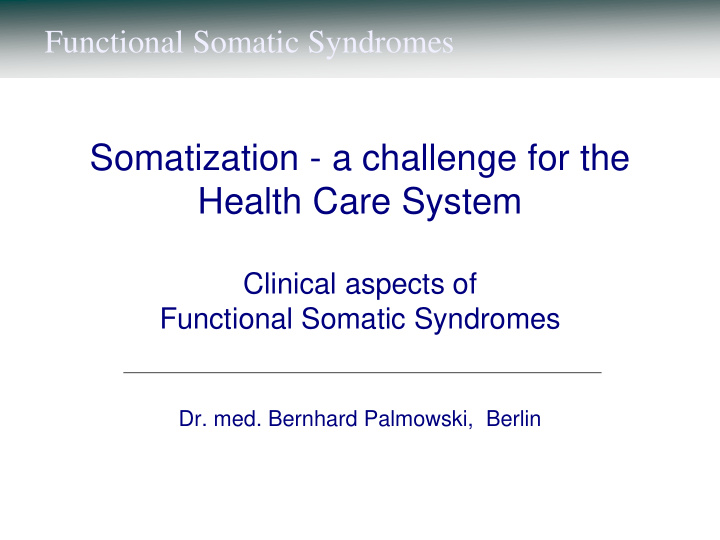



Functional Somatic Syndromes Somatization - a challenge for the Health Care System Clinical aspects of Functional Somatic Syndromes Dr. med. Bernhard Palmowski, Berlin
Functional Somatic Syndromes Guiding symptom is somatic Organ function impaired Organ structure retained Patient suffers physically!
Functional Somatic Syndromes Nomenclature Medically unexplained Symptoms Organ Neurosis Psychogenic Syndrome Somatisation Disorder Complex Somatic Symptom Disorder Bodily Distress Syndrome Functional Somatic Syndrome
Functional Somatic Syndromes Henningsen, Zipfel und Herzog; THE LANCET 2007 Management of Functional Somatic Syndromes Current classification acc. ICD10 as “Somatoform Disorder“ or “Somatization Disorder” unsatisfactory, because n out of touch with reality and medical framework n therapeutically counterproductive Mandatory requirements for useful terminology 1. acceptable for patients 2. useable for doctors 3. core theoretical concept
Functional Somatic Syndromes „Functional“ Somatic Syndrome, 2 meanings according to Uexkuell: 1. impaired function of the organ 2. important function for psychodynamics
2. impaired specific 1. Pain organ function Functional Somatic Syndromes 3. generalized autonomic dysfunction
2. impaired specific 1. Pain organ function High Variability High Complexity High Chronificity 3. generalized autonomic dysfunction
Functional Somatic Syndromes Epidemiology 26% of the urban population suffer from a psychogenic disease
Functional Somatic Syndromes 3 out of 10 patients attending a GP’s surgery suffer from functional somatic complaints
Functional Somatic Syndromes Out of every 10 patients with a functional somatic disorder: physical complaints physical complaints physical complaints and anxiety and depression only 2 3 5
Functional Somatic Syndromes P at atie ient nts s wit ith h FSS / So / Soma matis tisation ation in comparison with other medical patients show considerably higher values in: n number of physicians n appointments with physicians n in-patient treatment n emergency-room treatment n number of technical measures n inability to work n unemployability n unemployment
Functional Somatic Syndromes P at atie ient nts s wit ith h FS FSS S / Som / Somat atisation isation n incur appr. 100% higher costs than other medical patients n incur an estimated 20% of the overall medical costs in the USA n cost an estimated $ 256 million per year - pats. mit diab. mell. $ 132 million per year n do not have an increased use of psychiatric or psychotherapeutic care
Functional Somatic Syndromes Pathogenesis cognitive evaluation complex centr.nerv. activation Subjective perception symp./parasymp. reaction Affect expressive reaction endocrinal reaction gestures, facial expression, language, psychomot. immunolog. reaction mot. reaction
Functional Somatic Syndromes Pathogenesis defense - defense - defense - defense - defense - defense - defense defense - defense - defense - defense - defense - defense - defense defense - defense - defense - defense - defense - defense - defense Comple Vollständiges Erleben
Functional Somatic Syndromes Theoretical Clarification: Anxiety DD obsess. Fear Hypochondria Repression Defense Isolation Affect Conscious Cognition Cognition Unconcsious Affect
Functional Somatic Syndromes Doctors suffer when they cannot alleviate their patients’ suffering „difficult“ Psychosomatic Patients often are: angry, anxious, complaining, complicated, craving, dangerous, demanding, disappointed, embittered, entitled, extorting, fearful, fixated, frustrated, hurt, moaning, nagging, pressurizing, offended, obsessed, risky, scheming, stubborn … “no real patients”
Functional Somatic Syndromes Doctors suffer when they cannot alleviate their patients’ suffering „in trouble“ Doctors with these Patients often are: angry, anxious, confused, depressed, disappointed, embittered, extorting, fearful, fixated, furious, frustrated, hurt, insulted, nervous, obsessed, offended, overstrained, pressurizing, overwhelmed, tense, useless, worthless, left alone … “no good doctors”
Functional Somatic Syndromes Guidelines for Diagnosis and Therapy Compile and evaluate all findings obtain doctors’ letters - consistently! obtain external findings - consistently! make telephone contact with GP and ext. specialists complete insufficient or fragmented findings actively involve the patient, e. g. in tasks repeat discussions with the pat. about the findings, if needed All these are indispensable preconditions for Confrontation
Functional Somatic Syndromes Guidelines for Diagnosis and Therapy What is “confrontation” in Psychoanalysis? Description of the shared experience of the patient’s defensive behaviour within the transference The three most important words in psychoanalysis are: “I have noticed..”
Functional Somatic Syndromes Guidelines for Diagnosis and Therapy Formulations: - absolute counter-indications: “There is nothing wrong with you.” “There is nothing there.” “There never was anything there.” “You are in good health”. “Organically, you are in good health,” etc. - relative counter-indications: “You are depressed.” “You are mentally disturbed.” “In your case, there is a mental cause,” etc.
Functional Somatic Syndromes Guidelines for Diagnosis and Therapy Procedure: Step 1 – Recognize the organic disorder explanatory intervention, for example: “Your complaints are due to a disturbance in the function of the organ. The tissue has not been damaged.”
Functional Somatic Syndromes Guidelines for Diagnosis and Therapy Procedure: Step 2 – Produce the link with the affect helpful intervention, for example: “The function of an organ is often closely linked to internal feelings and moods. Do you often feel inwardly restless, tense and under pressure?”
Functional Somatic Syndromes Guidelines for Diagnosis and Therapy Procedure: Step 3 – Enter the psycho-social constellation helpful intervention, for example: “The sources of restlessness, tension and pressure are not always obvious. There must be something in your life. Would you like to tell me a bit more about yourself?“
Functional Somatic Syndromes Guidelines for Diagnosis and Therapy Procedure: Step 4 – Give feedback to referring colleague Write an early+short+simple care recommendation letter including - all diagnoses - short note on recommended or planned interventions
Functional Somatic Syndromes 1. Cave! overdiagnosed underdiagnosed patients patients
Functional Somatic Syndromes 2. Cave! iatragenically psychogenically somatically somatically fixated patients fixated patients
Functional Somatic Syndromes 3. Cave! primary / secondary primary / secondary gain of patient gain of doctor
Functional Somatic Syndromes 4. Cave! defence against defence against psycho-social conflict somatic illlness by somatisation by psychologising
Recommend
More recommend